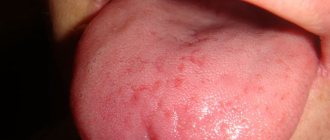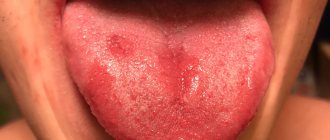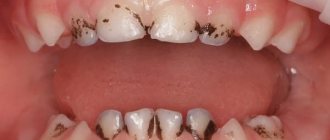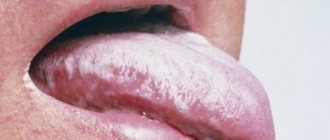7135
All parents, of course, care about the health of their children. At the slightest change in the appearance of any organs, they become very worried and try to immediately show the baby to the doctor.
However, to a lesser extent this applies to such an important part of our body as the tongue. The thing is that it is practically invisible in everyday life. And if, in addition, nothing bothers the child or he simply doesn’t think about it, then moms and dads can miss quite significant symptoms of the initial stages of some diseases.
In medical practice, the parameters of the appearance of the tongue are quite clearly defined, which are considered the norm. Its ideal condition in a healthy person, and in a child in particular, is soft, pale pink in color with clearly defined papillae
.
Plaque is also eliminated, except for light white plaque, usually in the morning, which is washed off with regular rinsing. There should be no spots of any color, especially red.
. Any such changes may indicate the onset of a disease, because the tongue is practically the calling card of the health of the whole organism.
What it is
In a healthy child, the tongue has a uniform pink color without spots or plaque. But in the presence of any pathology, spots of various colors and sizes may appear, which represent:
- An uneven accumulation of plaque on the surface of the tongue, which consists of exfoliated epithelium, tiny food particles, and microorganisms.
- Excessive proliferation of epithelium in certain areas of the mucous membranes.
- Limited inflammation.
- Benign or malignant neoplasms.
Let's look at the main reasons for the appearance of various spots and methods of treating them.
Reasons for appearance
The reasons for this phenomenon can be very diverse - from simple mechanical damage to serious illnesses. In this case, the spots can vary greatly in shade, shape, location and number
.
It is worth talking about such diseases in more detail. The list is structured in such a way that diseases are arranged in order of decreasing prevalence - from the most common to the rarer.
Stomatitis
Red spots are most likely due to one of the types of stomatitis - aphthous
. Painful ulcers (aphthae) and red spots may appear on the mucous membrane of the tongue and throughout the mouth.
If at the same time the temperature also rises, unpleasant and painful sensations and burning sensations appear in the affected areas, then these are certainly symptoms of aphthous stomatitis.
During illness, an inflammatory process begins in the oral cavity, which can be caused by multiple factors. These include decreased immunity, chemical, mechanical damage or burns due to infection, allergies, lack of nutrients, vitamin deficiency, and much more. Treatment of aphthous stomatitis in children should be prescribed by a dentist after examination.
We will tell you in detail about the treatment of mouth ulcers, giving many recipes.
This article explains why a white coating forms on a child's tongue.
Here: https://www.vash-dentist.ru/lechenie/bolezni-polosti-rta/stomatit-bpr/kak-proizvoditsya-kandidoznogo.html - talks about the treatment of candidal stomatitis in children.
Herpes
This is a very common viral disease. The herpes virus, after entering the body, remains there constantly and most of the time does not manifest itself in any way. However, during periods when the body is weakened (colds, fatigue, other diseases), the virus begins to actively function.
At the same time, red spots appear in the area of the tongue, palate, lips and cheeks, which soon turn into bubbles. They subsequently burst and leave behind red erosions.
This virus can also manifest itself as one of the types of stomatitis in children - herpetic. It is impossible to completely remove the pathogen from the body.
In fact, all treatment comes down solely to making relapses as rare as possible. The drug for local effect on the affected areas should, as in all other cases, be prescribed by a specialist.
Scarlet fever
This disease, which is classified as infectious, occurs most often in childhood. Caused by streptococcus. Carriers can be people who are carriers of streptococcus itself or have a sore throat.
During the course of the disease, red spots appear not only on the tongue, but also on the palate, throat, and tonsils. The tongue itself, under the toxic influence of the disease, becomes a very bright color - a “crimson” tongue.
It is quite easy to recognize the disease, since along with spots on the surface of the tongue, symptoms also include high fever, chills, the appearance of a rash throughout the body and a sore throat.
Glossitis
Red spots do not always appear with this disease, but often enough for it to be included in the list of the most likely causes. This is an infectious lesion of the tongue caused by various injuries or pathogenic microorganisms.
With it, an inflammatory process begins , which causes swelling, dryness and discomfort.
. Small red spots that appear as painful sores.
Dysbacteriosis
If the baby has been forced to take antibiotics or any antibacterial drugs for a long time, the entire digestive system may suffer. In this case, quite often one of the symptoms is the appearance of spots on the tongue, which have a characteristic red color and various sizes.
Geographic language
This is a dystrophic-inflammatory disease. With it, areas appear on the surface of the tongue in which the upper layer of the epithelium is exfoliated. They have a bright pink or red color and are surrounded by a white-yellow or gray rim
.
Their location is chaotic, and their shape and size are completely different. The name of the disease comes from the fact that the appearance of the tongue resembles a physical map of the world. Most often, there are no painful or intense unpleasant sensations.
There are quite a few reasons for a child’s geographic language:
- neuropathic and endocrine diseases;
- problems with the gastrointestinal tract;
- vegetative-vascular dystonia;
- diathesis;
- process of teething;
- helminthic infestations.
This may also be an individual feature of the child’s body.
Dr. Komarovsky talks about such red spots on a child’s tongue in the following video:
Hypovitaminosis
Vitamin deficiency can affect the body in completely different ways. This greatly depends on which particular vitamin (or group of vitamins) the baby lacks. In most cases it turns out to be a deficiency of vitamin B 12
.
Allergic reaction
An allergic reaction of the body to any factor can also cause redness in the form of spots in certain areas of the tongue. These reactions also include asthma.
. In this case, small redness on the surface of the tongue is quite noticeable.
The reasons for the appearance of a brown coating on a child’s tongue are discussed in our review.
This article explains how to treat oral thrush in a baby.
Here: https://www.vash-dentist.ru/lechenie/bolezni-polosti-rta/vozmozhnyie-prichinyi-plohogo-zapaha.html - the reasons for bad breath in a child are announced.
Tumors
It is quite rare for cases when poor-quality education in the field of language begins to develop. One of its first symptoms is the appearance of red spots on the surface.
Kawasaki syndrome
Refers to autoimmune diseases. The causes of the occurrence have not been described, although some experts talk about a virus or other similar pathogen.
The course of the disease begins with a strong increase in temperature, then a rash appears throughout the body, including on the tongue and mucous membranes
. This disease is most dangerous due to weakening and damage to the coronary arteries and complications in the heart.
White
In a baby, the appearance of white spots on the tongue most often indicates thrush - a fungal infection of the mucous membranes due to a decrease in immune defense in the body or when taking antibiotics. Such spots are located asymmetrically, can have a variety of sizes, and are often covered with a cheesy coating.
If a child shows signs of thrush on his tongue, then it is necessary to visit a pediatrician who will find out the reasons for its appearance. Delay in treatment can cause progression of the disease and inflammation of the mucous membrane, which will cause pain and discomfort in the child. You cannot try to remove the plaque on your own; this can lead to additional trauma. To eliminate such white spots, it is most often recommended to treat the child’s oral cavity with a weak solution of baking soda or ordinary brilliant green. In more severe cases and with relapse of the disease, it may be necessary to take antifungal drugs.
Principles of seizure therapy
Convulsive conditions in children require close monitoring by neurologists. Treatment of seizures is carried out in an inpatient department. It is aimed at normalizing metabolic processes in the child’s body and eliminating pathological processes in the brain. Drug therapy is selected for each child individually and depends on the type of seizures and the cause of their occurrence.
If a generalized (full-blown) seizure occurs, it is necessary to call an ambulance, since the child must be given sedatives and anticonvulsants. Before the doctors arrive, the baby should be undressed and freed from diapers. If the attack drags on, the baby is hospitalized in the intensive care unit for further emergency measures.
Unfortunately, even complex therapy does not always guarantee complete recovery, but timely contact with specialists can prevent complications and reduce the duration of the rehabilitation period.
Geographical
If red spots and a white coating along their edges appear on the tongue, then this is a sign of a geographic tongue - desquamative glossitis. The disease is not inflammatory in nature and may indicate some hormonal disorders, worms and problems in the digestive system. Such spots do not have smooth outlines, they quickly change their location and do not bother the child in any way. They can be oval, round or have fancy shapes.
This disease lasts a long time and often goes away on its own after some time, even without specific therapy. Sometimes antiseptics, vitamins and drugs that accelerate tissue regeneration processes are used to treat geographic tongue. But most experts (for example, Dr. Komarovsky) believe that there is no need to treat geographic spots.
Treatment of desquamative glossitis
Desquamative glossitis does not belong to the category of dangerous diseases with serious consequences. Many parents, seeing that their son or daughter’s tongue is peeling off, panic, fearing that such changes in the mucous membrane could develop into oncological tumors. These fears are completely unfounded. Desquamative glossitis never develops into cancer.
If geographic tongue is a secondary symptom of another, underlying disease, treatment should be comprehensive.
To eliminate discomfort, itching and burning on the mucous surface of the tongue, painkillers can be used. In order to save yourself from discomfort, you must definitely exclude from your diet all spicy, salty, sour, too hot and cold foods.
Antiseptic rinsing of the mouth is necessary several times a day. For this purpose, special disinfectant medications are used, which are prescribed by the doctor.- An oil bath gives an excellent effect. You can take sunflower, corn or olive oil, which is heated in a water bath for 20-25 minutes.
- A thorough sanitation of the oral cavity is carried out - timely treatment of carious teeth, gum diseases, systematic cleaning.
- Taking multivitamin complexes will be an effective addition to the course of treatment. But in no case should you choose them yourself - you should definitely consult with a specialist.
Adult men and women are recommended to give up many bad habits - smoking, frequent consumption of strong alcoholic drinks, as well as sweets and other foods with a lot of sugar.
Reds
The appearance of red spots on a child’s tongue is a sure sign of an infectious or inflammatory process in the oral cavity:
- stomatitis;
- glossitis;
- bacterial dermatosis;
- herpetic infection.
Also, red spots may be due to an allergic reaction or consumption of foods that are bright red in color.
Very often, such formations are accompanied by unpleasant symptoms: pain in the tongue, a feeling of discomfort, increased salivation. Due to pain, children may be capricious and refuse to eat or drink. The general condition may also suffer - body temperature rises.
Only a doctor should treat red spots. After establishing an accurate diagnosis, the following may be prescribed:
- treatment of lesions with antiseptic agents;
- taking antibiotics or antivirals;
- use of anti-inflammatory medications.
Dark
Dark spots on the tongue often occur when eating food that contains dark pigments that color the plaque on the surface of the mucous membranes. Such spots do not pose any danger to the child and disappear after hygiene procedures. But there are a number of conditions that manifest as dark spots in the mouth and which can have very serious consequences.
Black
Black spots on the tongue in children most often appear during a long course of antibiotic therapy as a result of the active proliferation of microorganisms and fungi. Blackening of the tongue develops gradually and can last up to 2-3 weeks. The main treatment for this condition is to restore normal microflora in the child’s intestines and oral cavity. For this purpose, eubiotic drugs are prescribed (for example, Linex, Bifidumbacterin, Lactobacterin).
It is extremely rare that black spots on the tongue appear as a result of deep degenerative processes accompanied by necrosis of areas of the mucous membrane. This condition is very dangerous and requires emergency medical attention. The treatment of such spots is often surgical.
Blue
Blue spots in a child's mouth are a rare occurrence. They may appear in the following situations:
- The presence of severe heart failure due to heart disease and defects. Spots on the tongue appear due to stagnation of blood in the venous bed and are accompanied by blue discoloration of the lips and limbs. Their treatment consists of eliminating cardiac pathology and normalizing blood microcirculation in the vessels.
- With the growth of a benign vascular tumor - hemangiomas. This blue spot is most often single. Treatment is only possible through surgery.
How to treat spots on the tongue?
Treatment of any changes in a child’s oral cavity should be based on eliminating the cause of the problem. Approaches to the treatment of spots on the tongue are varied, since not only dental diseases can cause them.
Most often, the child and parents are faced with stomatitis or a fungal infection of the oral cavity. Principles for treating this problem:
- careful adherence to oral hygiene;
- taking antibacterial or antiseptic drugs, most often local in the form of sprays and rinses;
- taking local antifungal agents (in case of candidiasis, but not for prevention);
- taking local immune activators.
In the case of spots on the tongue as a manifestation of an allergic reaction, you first need to determine what caused it and stop contact with the irritating substance. Additionally, antihistamines are used. In some cases, allergy symptoms appear due to incorrect, too rapid introduction of complementary foods to infants4.
If spots form due to a herpes infection, antiviral agents should be used, most often acyclovir drugs. Treatment of blisters and sores should be carried out using hydrogen peroxide, and then lubricated with an oil solution based on eucalyptus. Vitamin complexes and immune medications will help speed up recovery.
Spots that arise as a result of disturbances in the gastrointestinal tract disappear after exposure to the cause of the problem. Depending on the disease, the child may be prescribed medications that improve gallbladder function, normalize acidity in the stomach, probiotics and live beneficial bacteria to improve intestinal function.
Bald
Normally, the lingual surface is covered with a large number of small taste buds, which give it a velvety appearance. If such papillae die or atrophy for any reason, “bald” spots appear. They are pink in color, irregular in shape and do not spread to the mucous membranes of the cheeks, lips or gums.
Reasons that can cause the appearance of such pink “bald” spots:
- Inflammatory diseases (glossitis, stomatitis).
- Tongue injuries.
- Burns from heat or chemicals.
“Bald” spots do not cause any inconvenience to children, but may slightly change the taste sensations. It is impossible to cure such formations, since the taste buds cannot be restored.
If you find that your one-year-old or older child’s tongue has become spotted, you should not panic and try to treat it yourself. Also, the appearance of spots on the tongue should not be ignored, as they may indicate the presence of serious diseases. It is necessary to consult a doctor who will find out the exact cause of such changes and, if necessary, select appropriate treatment for the child.











